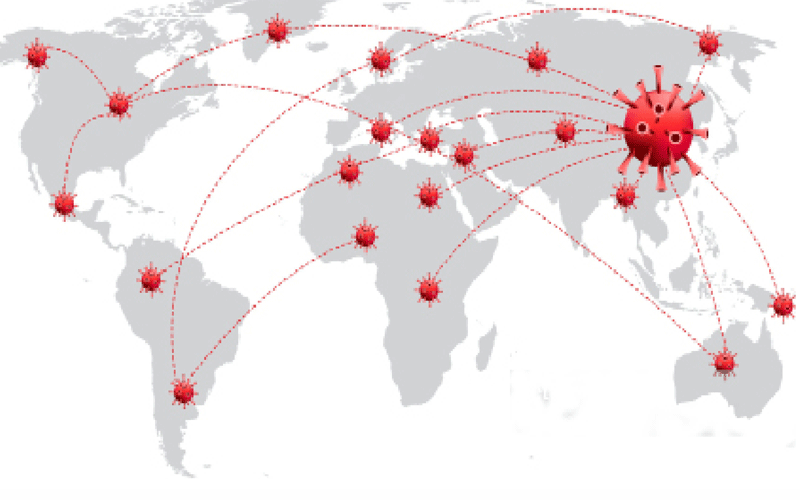Ten pandemics in world history

On March 11, this year, World Health Organisation declared the outbreak of novel coronavirus a pandemic, with severe repercussions to human health and global economic activity. Yet Covid-19 is not the first widespread disease that the world has faced, writes MILLIAM MURIGI.
1 Covid-19
On March 11, 2020, the World Health Organisation announced that Covid-19 was officially a pandemic after barreling through 114 countries in three months and infecting over 118,000 people.
Covid-19 is caused by a novel coronavirus strain that has not been previously found in people.
The first reported case was in China in November 17, 2019, but went unrecognised. Without a vaccine available, the virus spread beyond Chinese borders and today, it has been reported in almost every country of the world.
Symptoms include respiratory problems, fever and cough, and can lead to pneumonia and death.
There are no specific drugs to treat Covid-19 infection. People who are sick receive supportive care to help relieve symptoms. For severe cases, include care to support vital organ functions.
2 HIV/Aids
With vast improvements in treatment, information, diagnostic capabilities, and surveillance in Western countries, it is easy to forget that HIV is still a pandemic.
The disease was first identified in Democratic Republic of the Congo in 1976 before it spread to other countries.
Since the early 1980s, HIV has claimed the lives of more than 36 million people. At the end of 2018, between 31 and 35 million people were living with HIV with more added every day.
Treatments have been developed to slow the progress of the disease, but a cure is yet to be found.
3 The Plague
No article on pandemics would be complete without mentioning the Black Death, also referred to as The Plague.
Peaking in Europe between 1347 and 1351, the Black Death was responsible for an estimated 75 to 200 million deaths. In fact, it may have killed half of the entire population of Europe.
This pandemic was caused by a bacterium, Yersinia pestis, rather than a virus.
Epidemiologists believe that the Black Death also originated in Asia. Like Covid -19, plague transmitted via respiratory droplets.
However, the Black Death’s march across the planet was enabled by rodents rather than the movement of humans. Rodents carrying bacteria-infected fleas spread this disease.
4 Asian Flu
This Flu started in 1956 in Hong Kong before it spread to China, United States, and finally in England where over six months 14,000 people died.
A second wave followed in early 1958, causing an estimated total of about 1.1 million deaths globally, with 116,000 deaths in the United States alone.
A vaccine was developed later, effectively containing the pandemic.
5 Spanish Flu
Between 1918 and 1920 a disturbingly deadly outbreak of influenza tore across the globe, infecting over a third of the world’s population and ending the lives of 20 to 50 million people.
Of the 500 million people infected in the 1918 pandemic, the mortality rate was estimated at 10 per cent to 20 per cent, with up to 25 million deaths in the first 25 weeks alone.
What separated the 1918 flu pandemic from other influenza outbreaks was the victims; where influenza had always previously only killed juveniles and the elderly or already weakened patients, it had begun striking down hardy and completely healthy young adults, while leaving children and those with weaker immune systems still alive.
By October, hundreds of thousands of Americans died. The good thing is that the flu threat disappeared in the summer of 1919 when most of the infected had either developed immunities or died.
6 Small pox
Smallpox ranks among the most devastating illnesses ever suffered by humankind. Officially, the deadly virus no longer exists.
After a final outbreak in the United States in 1949, the virus was declared eradicated following a successful vaccination programme regarded as one of the greatest triumphs of modern medicine. The disease has killed between 300-500 million people.
7 Cholera
Many people think of cholera as a 19th century disease. This is true for high-income countries.
But elsewhere, cholera never went away. The current pandemic the seventh that has been recorded has been ongoing since 1961.
It is the world’s longest running pandemic. Cholera sickens approximately 2.9 million people every year, and kills 95, 000.
The disease is endemic in more than 47 countries across the globe. In Africa alone, more than 40 million people live in cholera “hotspots” where outbreaks are a regular occurrence.
Factors driving the outbreaks include climate change, forced migration, prolonged conflict, urbanisation, population growth, and poor access to health services.
Fundamentally though, cholera is the result of a lack of adequate water and sanitation.
8 Severe Acute Respiratory Syndrome (SARS )
First identified in 2003 after several months of cases, Severe Acute Respiratory Syndrome is believed to have possibly started with bats, spread to cats and then to humans in China, followed by 26 other countries, infecting 8,096 people, with 774 deaths.
SARS is characterised by respiratory problems, dry cough, fever and head and body aches and is spread through respiratory droplets from coughs and sneezes.
Quarantine efforts proved effective and by July 2003, the virus was contained and hasn’t reappeared since.
9 H1N1 Swine Flu
The H1N1 swine flu pandemic of 2009-2010 was caused by a new strain of the same virus that caused the Spanish flu.
The swine flu infected an estimated 700 million to 1.4 billion people, which was far more in absolute terms compared with the Spanish flu.
But the mortality rate was far less, at an estimated 0.01 per cent to 0.08 per cent, according to an analysis published in the journal, The Lancet.
Both swine flu and the novel coronavirus cause symptoms such as fever, chills, a cough, and headaches.
10 Ebola
Ebola ravaged West Africa between 2014 and 2016, with 28,600 reported cases and 11,325 deaths.
It is believed to have originated in bats. The first case to be reported was in Guinea in December 2013, then the disease quickly spread to Liberia and Sierra Leone.
The bulk of the cases and deaths occurred in those three countries. A smaller number of cases occurred in Nigeria, Mali, Senegal, the United States and Europe, the Centres for Disease Control and Prevention reported.
This is why on August 8 2014, WHO declared the epidemic to be a “public health emergency of international concern”.















